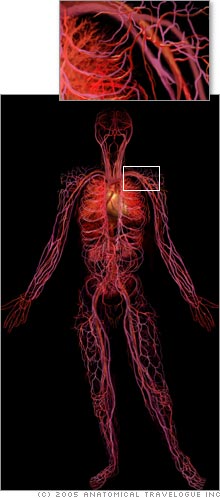 |
| This image, nicknamed the vascular dude, shows the human body's circulatory system. |
|
|
|
NEW YORK (CNNMoney.com) -
Forget your fears about a bird flu pandemic. Cardiologists say that the blood pressure pandemic is already here.
About one-third of all Americans have high blood pressure, which contributes to more than 10 percent of U.S. deaths, according to the American Heart Association. For drug makers, this translates into a $30 billion market which many see growing much larger as the baby boomers get older. Furthermore, most people with hypertension don't even know they have it, which means they haven't been treated yet and Swiss drug maker Novartis is betting on this untapped market.
Novartis is an active player in the blood pressure sector. The Basel-based company, which had $28.2 billion in 2004 sales, makes the blood pressure drug Diovan, which had sales of nearly $1 billion in the third quarter alone. Novartis is also planning to file an experimental blood pressure drug aliskiren with the FDA in the first quarter of 2006.
But Novartis (down $0.35 to $52.46, Research) is not alone. Pfizer's (down $0.21 to $21.26, Research) competing blood pressure drug Norvasc totaled $4.5 billion in 2004 sales, while BristolSmithKline's (down $0.20 to $21.70, Research) Avapro and Avalide (a drug combination that contains Avapro) totaled $930 million in 2004 sales.
Drug makers' advertising practices have been criticized and the companies have increased efforts to repair their image. Novartis is unveiling flashy new educational material, which the company says is not an advertisement and is intended as a public service. The company is underwriting an educational project on heart disease to disseminate high-tech imagery of the human vascular system. The images, provided by Alexander Tsiaras, CEO of Anatomical Travelogue, offer stunning and sometimes bizarre visuals of ruptured blood vessels, cross-sectioned hearts and a fetus' circulatory system. The images include a landscape of the body's arteries, veins and capillaries nicknamed the "vascular dude."
"Now, with these images, you could really show people the consequences of uncontrolled blood pressure," said Novartis spokeswoman Anna Frable. Frable said Novartis is using the images for educational purposes and said that "education in this particular category is good business sense."
The images are not illustrations, says Novartis, but digitized and colorized images taken from ultrasounds, MRIs, CTs and other forms of medical diagnostics through a graphics process developed by Tsiaras. Novartis has made the images available online at its site www.seeyourbp.com, which has links to an education site and a commercial site that contains information about programs and products.
"It certainly adds a more positive image [to the drug industry,]" said Al Rauch, analyst for A.G. Edwards. "They're trying to educate people about their product and/or the disease. It's not crude advertising or trying to force a product down people's throats; it's providing a public service by drawing attention to people's need for blood pressure treatment."
Nicholas Turner, analyst for Jeffries & Co., said that only 30 percent of people with hypertension have been diagnosed, so Novartis' education campaign could motivate many patients to seek treatment, possibly with Novartis' products.
"You have to bear in mind that Novartis has been involved in hypertension awareness and education programs for some time, and at least part of that program is geared towards pushing sales of Diovan," said Turner. "You could look at this cynically, or you could look at this as a valuable education tool and a means by which you can treat high blood pressure."
Will the vascular dude work?
Novartis does not name products in its use of the images so it is not considered advertising. Nonetheless, Bob Barocci, CEO of Advertising Research Foundation in New York, said Novartis' new education campaign and its emphasis on providing health information is close to what the Food and Drug Administration intended when it lifted the ban on direct-to-consumer (DTC) advertising in 1998. Since the ban was lifted, DTC advertising has grown into a $4 billion industry, but has created controversy with its "ask your doctor" style television ads.
"[The drug makers] are trying to figure out how to do it differently because the FDA was putting a whole lot of pressure on them to change," said Barocci.
Barocci added that Novartis' hypertension education program "doesn't smack of an image-building activity, " but "an attempt to provide better information, which is what the FDA wants, and which is what drug advertising should be about."
Novartis is mulling additional ways to make the images accessible to the public. Novartis' Frable said the images might be included in customized information packets that are sent to patients or are used by physicians in discussions with their patients.
Novartis would not say how much it has spent on the education program. But Barocci said the Novartis program "has got to be a lot cheaper" than the $100 million to $200 million that drug makers typically spend on advertising individual drugs.
But how effective will Novartis be in disseminating the information?
As an experiment, Barocci Googled the phrase "blood pressure" and the Novartis hypertension web site was the first hit.
"That tells me that they're serious about telling whoever their target is about blood pressure," said Barocci. "They bought that [site,] so they're integrated and organized.
-----------------------------------------------------------------------
The analysts Rauch and Turner do not own shares of Novartis stock.
To find out how much drug companies are spending on direct-to-consumer advertising, click here.

|